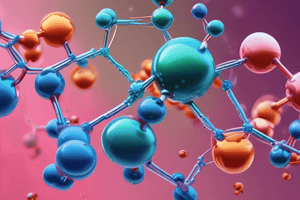Podcast
Questions and Answers
Why are transition metals and their compounds effective catalysts?
Why are transition metals and their compounds effective catalysts?
- They exhibit diamagnetic properties.
- They possess a fixed oxidation state.
- They readily form ionic bonds with reactants.
- They can exist in multiple oxidation states. (correct)
Why is zinc not considered a transition metal?
Why is zinc not considered a transition metal?
- It has a low melting point compared to other transition metals.
- It has a completely filled d-orbital in its ground state. (correct)
- It does not form colored compounds.
- It readily loses electrons.
How many geometrical isomers are possible for the complex ion $[CoCl_2(en)_2]^+$?
How many geometrical isomers are possible for the complex ion $[CoCl_2(en)_2]^+$?
- Three
- Two (correct)
- Four
- One
Which of the following is the correct IUPAC name for $[Cr(NH_3)_5CO_3]Cl$?
Which of the following is the correct IUPAC name for $[Cr(NH_3)_5CO_3]Cl$?
Which of the following best describes a bidentate ligand?
Which of the following best describes a bidentate ligand?
What is the primary difference between lanthanoid and actinoid contraction?
What is the primary difference between lanthanoid and actinoid contraction?
Which of the following complexes is an anionic complex?
Which of the following complexes is an anionic complex?
Select the correct IUPAC name for the coordination compound $[Co(en)_3]^{3+}$
Select the correct IUPAC name for the coordination compound $[Co(en)_3]^{3+}$
What characteristic defines a polydentate ligand?
What characteristic defines a polydentate ligand?
Identify the coordination compound from the options below.
Identify the coordination compound from the options below.
Flashcards
Why are transition metals good catalysts?
Why are transition metals good catalysts?
Transition metals can exist in multiple oxidation states, allowing them to gain or lose electrons readily during a reaction.
Why isn't Zinc a transition metal?
Why isn't Zinc a transition metal?
Zinc has a fully filled d-orbital in its ground state and excited states.
Monodentate Ligand
Monodentate Ligand
A ligand that coordinates through one donor atom.
Bidentate Ligand
Bidentate Ligand
Signup and view all the flashcards
Polydentate Ligand
Polydentate Ligand
Signup and view all the flashcards
Anionic Complex
Anionic Complex
Signup and view all the flashcards
Lanthanoid/Actinoid Contraction
Lanthanoid/Actinoid Contraction
Signup and view all the flashcards
Study Notes
- Study notes about Coordination Compounds.
Transition Metals and Catalysis
- Transition metals and their compounds are effective catalysts due to their ability to exist in multiple oxidation states
- They can gain or lose electrons during a reaction
Zinc as a Transition Metal
- Zinc is not considered a transition metal
- It has fully filled d-orbitals in its unexcited (ground) state and all excited states
IUPAC Nomenclature of Coordination Complexes
- [Cu(NH3)4Cl2]+ is named Tetraaminedichloridochromate (III)
- [Co(en)3]3+ is named Tris(ethane-1,2-diamine)cobalt (III) ion
- [Co ONO(NH3)5]Cl2 is named Pentaaminenitrito-o-cobalt (III) Chloride
- [Cr(NH3)5CO3]Cl is named Pentaamminecarbonatochromium (III) Chloride
Isomers of [CoCl2(en)2]+
- [CoCl2(en)2]+ has two geometrical isomers (cis- and trans-)
- It has one optical isomer (cis-)
Ligands
- Monodentate ligands definition required, see text book/Notes
- Bidentate ligands definition required, see text book/Notes
- Polydentate ligands definition required, see text book/Notes
Coordination Compound
- Coordination Compound definition required, see text book/Notes
Anionic Complex
- An anionic complex is a complex ion that has a net negative charge
Organometallic Compound
- Organometallic definition required, see text book/Notes: organometallic compounds contain one or more metal-carbon bonds
Lanthanoid and Actinoid Contraction
- Differentiate between lanthanoid and actinoid contraction, giving two points, see text book/Notes
Studying That Suits You
Use AI to generate personalized quizzes and flashcards to suit your learning preferences.




